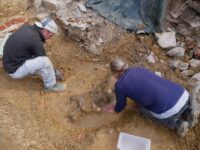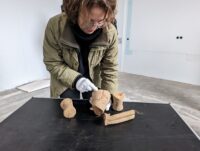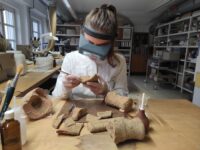Paderborn isn’t the hinterlands anymore. It’s a major city in the northwestern German state of North Rhine-Westphalia and has been since it was founded in the late 8th century by Charlemagne who built a castle nearby. When Augustus ruled the Roman Empire in the first years of the first millennium, however, there was no city there. There was a Roman military camp in Anreppen, less than 10 miles to the east, but it was a flash in the pan, occupied between 4 A.D. and 10 A.D. at the latest, abandoned in the wake of the Varus’ defeat at the Battle of Teutoburg Forest. (Kalkriese, where the epic battle took place, is 60 miles to the north of Paderborn.) Only a smattering of Roman objects have ever been found in Paderborn and they were likely brought there by locals who acquired them as booty or trade goods.
 So when archaeologists excavated a parking lot in the city center in advance of new construction, they expected to find medieval and modern remains, not ancient ones. The assumption seemed accurate at first; the first discoveries made at the site dated to the 7th and 8th centuries. Then, on the last day of the excavation, the team unearthed a pit 5.2 feet deep that contained charcoal and ash from a fire topped by the skeletal remains of a boar. In that same pit were four large fragments from Roman amphorae.
So when archaeologists excavated a parking lot in the city center in advance of new construction, they expected to find medieval and modern remains, not ancient ones. The assumption seemed accurate at first; the first discoveries made at the site dated to the 7th and 8th centuries. Then, on the last day of the excavation, the team unearthed a pit 5.2 feet deep that contained charcoal and ash from a fire topped by the skeletal remains of a boar. In that same pit were four large fragments from Roman amphorae.
Amphorae were the workhorse transport vessel of the Greco-Roman world. They have been found by the thousands, but these are the first amphora pieces ever discovered in Paderborn. And they weren’t from just any old amphorae. The maker’s stamp identifies them as vessels used specifically to transport Falernian wine, the highest quality and highest cost wine in the Mediterranean. The white wine was produced in central Italy from grapes grown on the slopes of Mount Falernus and aged for up to 20 years in clay amphorae. The aging process maderised (oxidized) the wine, darkening it to an amber color and ramping up the alcohol content to about 15% ABV.
The fact that Paderborn attracted famous personalities as early as the early Middle Ages is nothing new: “The traces of Emperor Charlemagne and famous bishops and builders like Meinwerk shape our daily work just as much as the remains of the luxury items that they brought to the city,” says Dr . Sveva Gai, city archaeologist of Paderborn. “But no one expected the shards of Roman wine amphorae that date back to the time of Emperor Augustus at this location,” explains the LWL archaeologist. […]
The few Roman finds that have so far been found in the Paderborn urban area are younger than the Roman camps in Westphalia. They are mostly interpreted by experts as trade or booty in a Germanic context. However, settlement remains of native Germanic tribes have not yet been found at St. Johannesstift and in the surrounding area.
“On the contrary, the presumed fountain and the remains of the amphora clearly indicate that it was used by Roman legionnaires – possibly a sentry post,” says Tremmel. This is supported by the central location of the find site on a hilltop that is still four meters high and bordered on the north and east by the Pader and its springs and on the west by the Rimbeke. “But the area of the hill was not large enough for a Roman camp. That’s probably why there was only a Roman watchtower here, which could also have served as a small supply depot,” speculates Tremmel.

